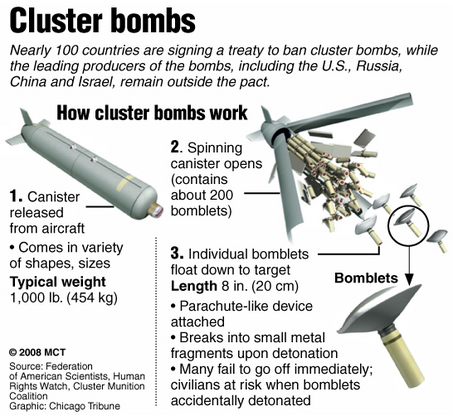Who’s to blame for Ukraine’s use of cluster bombs?

Remnants of a possible cluster bomb lying in front of a burning house in Donetsk, Ukraine, on October 5, 2014.
While debate continues in Washington over whether the United States should arm the Ukrainian government in its war against the people of the eastern regions of its territory, there remains a bit of a disconnect over the reality that Ukraine is already using cluster munitions that are banned by an international treaty that has been in effect since 2010. In important ways, the U.S. provides the diplomatic cover for Ukraine to use these munitions, if not the weapons themselves.
Last week, the Organization for Security and Cooperation in Europe’s Special Monitoring Mission to Ukraine (SMM) reported that it has uncovered evidence that cluster bombs have been used in the shelling of civilian neighborhoods in Luhansk:
The SMM saw considerable damage caused by the impacts of rocket shelling, such as broken windows, fences, gates and walls. The SMM assessed that some of the damage to the buildings, e.g. a series of parallel rows of strike marks on a gate and wall, were consistent with damage typically caused by shrapnel elements from cluster munition. According to the SMM’s assessment, a hole in a roof of a house was caused by the impact of what appears to be a bomblet, with small calibre.
The SMM discovered parts of rockets, including engines, fins and cargo compartments, in the front and backyards of several houses; the cargo compartment in particular is typical of a rocket carrying cluster munitions. Some parts sighted by the SMM at the impact site (1.5 cm white metal fragments, 6 by 3 cm black metal fragments of bomblets cases) are typical for cluster munition. The SMM identified them as parts consistent with 9M55K model “Smerch” rockets (calibre 300mm). The SMM observed a crater (diameter approximately 4m, depth approximately 3m) at the backyard of the house located at Dekabristiv Street 106 which had been caused by the explosion of a “Smerch” rocket, according to the SMM’s assessment.
Following a report last year by Human Rights Watch alleging “widespread use of cluster munitions” by “Ukrainian government forces,” the OSCE had raised doubts about the veracity of these claims. As Deutsche Welle reported on October 23, 2014,
Michael Bociurkiw, spokesman for the OSCE mission in Ukraine, also denied that the Ukrainian military had used cluster bombs. “We have around 90 observers in eastern Ukraine,” he told DW. “If we had encountered anything like that, we would have reported it, but that hasn’t happened. Everything we can say about ammunition and shelling is in our daily reports.”
It now appears however that the OSCE is conceding that the Ukrainian government, which came to power following a violent U.S.-backed coup d’etat that toppled the democratically elected Viktor Yanukovych last February, is in fact using these heinous weapons against civilian populations.
Despite being banned under international law for their indiscriminate and disproportionate effects on civilians, they are a particular favorite of the United States, which has used them in Afghanistan, Albania, Bosnia and Herzegovina, Cambodia, Grenada, Iran, Iraq, Kuwait, Lao PDR, Lebanon, Libya, Saudi Arabia, Sudan, Vietnam, Yemen, former Yugoslavia (Kosovo, Montenegro, Serbia). No other country on earth comes close to using these weapons so extensively.
As International Campaign to Ban Landmines – Cluster Munition Coalition (ICBL-CMC) describes them,
A cluster bomb is a weapon that can contain up to several hundred small explosive bomblets. Dropped from the air or fired from the ground, cluster bombs break open in mid-air and scatter these bomblets over a wide area. Anyone within the strike zone is likely to be injured or killed, no matter if they are military or civilian. Many bomblets fail to explode as intended, leaving behind huge quantities of de facto landmines which continue to kill for years or even decades after their use.
Used in more than 35 countries, cluster bombs have killed and injured tens of thousands of civilians and devastated the livelihoods of countless more.
Senator John McCain, who serves as a Chairman of the Senate Committee on Armed Services, claimed last week that the United States is partly to blame for Ukraine’s use of cluster bombs since it hasn’t provided the country with other weapons.
“I think that if we had provided them with the weapons they need, they wouldn’t have felt they had to use cluster bombs. So, it’s partially our fault,” McCain said.
Perhaps more importantly than this, the United States provides Ukraine with unwavering diplomatic and political support, shielding the Kiev regime from criticism. Further, since last spring, the CIA has been directly working with the Ukrainian government on counter-insurgency tactics and on establishing a security apparatus. As AFP reported in May 2014,
Dozens of specialists from the US Central Intelligence Agency and Federal Bureau of Investigation are advising the Ukrainian government, a German newspaper reported Sunday.
Citing unnamed German security sources, Bild am Sonntag said the CIA and FBI agents were helping Kiev end the rebellion in the east of Ukraine and set up a functioning security structure.
The revelations of CIA involvement came following a visit to Kiev by CIA director John Brennan in April 2014, which the White House described as “routine,” but was condemned by Moscow as more U.S. meddling in the country.
Considering that the United States has long defended cluster bombs publicly and vehemently as useful tools in maintaining American hegemony in the world, is it any wonder that the Ukrainian government — being advised by the United States — would feel justified in using these bombs against civilians?
Indeed, according to the Pentagon’s 2008 policy, cluster munitions can actually be considered humane weapons. “Because future adversaries will likely use civilian shields for military targets – for example by locating a military target on the roof of an occupied building – use of unitary weapons could result in more civilian casualties and damage than cluster munitions,” the policy claims. “Blanket elimination of cluster munitions is therefore unacceptable due not only to negative military consequences but also due to potential negative consequences for civilians.”
The U.S government has effectively rejected the international ban on cluster munitions as inapplicable to the United States. In justifying the U.S.’s use of cluster bombs and its refusal to accede to the Convention on Cluster Munitions, Secretary of Defense Robert Gates said in 2008,
The U.S. did not participate in the Cluster Munitions Convention negotiations because we believe that cluster munitions are an integral part of our and many of our coalition partners’ military operations. The elimination of cluster munitions from our stockpiles would put the lives of our soldiers and those of our coalition partners at risk. There are no substitute munitions, and some of the possible alternatives could actually increase the damage that results from an attack.
In November 2009, an Obama administration State Department official said that “many States, including the United States, have determined that their national security interests cannot be fully ensured consistent with the terms of the [Convention].”
U.S. firms have also invested heavily in these banned weapons, spending at least half of the estimated $27 billion on producing cluster bombs from 2011 to 2014. While it is unclear what exactly is driving that increase, rights groups have reported on the recent use of cluster munitions in both Syria and eastern Ukraine.
“We’re seeing an increase in the total value of investment from just a year ago, so that’s a big disappointment,” Amy Little, a campaign manager at the Cluster Munition Coalition, a global advocacy network that includes PAX, told MintPress News in late 2014.
With the U.S. government the most vocal defender of these weapons and U.S. firms the most heavily invested in their production, it seems that it may be also the most instrumental in undermining the international norm against their use, thereby enabling the Ukrainian regime to drop them on its own people with impunity.

